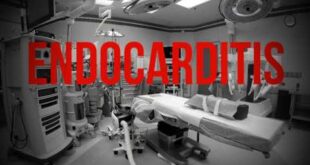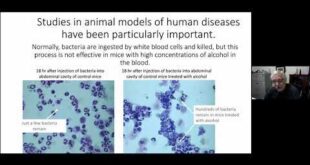The antibiotic regimen was then changed to nafcillin (2 g IV q4h) and gentamicin (3 mg/kg qday for 5 days) for MSSA positive endocarditis. The patient, however, did not improve and 2 weeks after admission, had a cardiac arrest and died. The key echocardiographic finding in right sided endocarditis is that of vegetation(s) in association with the tricuspid or rarely the pulmonary valve (fig 22).). As with vegetations on the left sided valves, they tend to be localised to the atrial side of the valve in the path of the regurgitant jet. Tricuspid vegetations are often large and may be in excess of 2 cm, a finding that does not necessarily suggest the presence of fungal endocarditis.
We often obtain our best views of the tricuspid valve via the transgastric window, while the pulmonary valve is usually best seen in the 60° mid oesophageal view. Rotation of the crystal array and angulation of the probe tip in order to visualise the valves in a number of orientations is mandatory during TOE. Antibiotic treatment should start immediately after blood cultures are obtained. For persistent and invasive infections, refractory heart failure and prosthetic valves, surgical intervention is indicated. However, the high recurrence rate caused by continuing IDU and medical non-compliance inevitably raises the ethical consideration of offering valve surgery to this patient population.
Management of Infective Endocarditis in People Who Inject Drugs
Mycotic aneurysms of the pulmonary arteries may be complicated by potentially fatal pulmonary hemorrhage. Multiple pulmonary emboli may result in right sided chamber dilatation, right heart failure, and a worsening of tricuspid regurgitation. The embolisation of vegetations large enough to result in obstruction of a significant portion of the pulmonary arterial circulation has been described but is unusual in our experience. In keeping with the demographic characteristics of injection drug use, this disease occurs most commonly in young males in their 20s and 30s. At our institution, which may represent a peculiar demographic, males and females are equally affected.
Infective endocarditis, also called bacterial endocarditis, is an infection caused by bacteria that enter the bloodstream and settle in the heart lining, a heart valve or a blood vessel. IE is uncommon, but people with some heart conditions have a greater risk of developing it. HIV is a chronic autoimmune disease that can occur from a contaminated needle. IV drug users, especially those who share needles, are at an increased risk of developing HIV.
Infective endocarditis from IV drug use tied to hemorrhagic stroke
Myocardial protection was achieved with antegrade cold crystalloid cardioplegic solution. Mitral- and tricuspid valve procedures were performed with occlusion of both caval veins. Mitral- and aortic valve procedures were performed on the arrested heart and isolated tricuspid valve procedures were performed either in cardiac arrest or on beating heart according to surgeons’ preferences. There has been a continuous debate as to whether it is ethical to withhold valve surgery in an active, noncompliant drug user. The first valve surgery is normally offered to those patients who are willing to undergo drug rehabilitation program and be compliant with treatment. However, any IDU who becomes non-compliant, relapses, and acquires a second episode of IE generally will not be offered further valve surgeries (21).
Spontaneous bacteremia is also common as a result of poor dental hygiene, and susceptible patients need to be made aware of this. In the treatment of IE, from any source, fever may still be present 2 weeks after starting the appropriate treatment, even with drug-sensitive organisms. This could be due to the presence of an underlying large vegetation or abscess. If fever persists, the sensitivity of the infecting organism should be checked and drug levels monitored. Repeat echo should be performed to exclude increasing vegetation size or abscess formation.
CLINICAL
Antibiotics should not be initiated before three sets of blood cultures have been taken. Infective endocarditis (IE) is a significant risk and complication in patients with a history of intravenous (IV) drug use (DU), and treatments are becoming more invasive as infections become more serious. IV drug use is an extremely addictive behavior and challenging behavior to address, and patients are at high risk of relapse to IV drug use even after successful IE treatment.
Risk factors for children and young adults include birth defects of the heart such as malformed valves or a hole in the septum, which allow blood to leak from one part of the heart to another. VS projected the study, analysed and interpreted the data, and wrote the manuscript. PLS performed the surgical interventions, and was a major contributor in writing the manuscript. IM, NC, FV, ES and BA performed clinical follow up and contributed collecting the data for the analysis.
There are nonetheless some conceptual difficulties in uncritically applying the Duke criteria to right sided endocarditis. One should not allow the lack of a murmur, therefore, to preclude further investigation if the clinical suspicion is high. Immunologic and vascular phenomena, which feature as minor criteria in the Duke system, are also less common. Septic pulmonary emboli are listed as a minor criterion in the Duke scheme; it could be argued that this important diagnostic feature is somewhat underweighted in the present Duke criteria.

If the etiological agents are MRSA, coagulase-negative staphylococci, Pseudomonas aeruginosa, fungi, or HACEK, the treatment is similar to IE in non-IDU patients. MRSA is treated with vancomycin; however, treatment failures of MRSA with vancomycin are becoming increasingly common. Agents such as daptomycin, linezolid and quinupristin-dalfopristin are suggested as alternatives in cases of vancomycin-intermediate MRSA. For treatment of other uncommon pathogens, please read references (7, 15, 17–20, 24). If the cause of IE is injection of illicit drugs or prolonged use of IV drugs, the tricuspid valve is most often affected.
By 2017 the number of cases rose to 395, with drug use accounting for 177, which was about half of all cases. One out of every four patients admitted to The Ohio State University Health System for drug-related infective endocarditis died in the hospital system that same year. If immediate antibiotic treatment is warranted, this can be initiated right after completion of blood culturing, once microbiology tests have identified a specific organism and the antibiotic therapy has been modified accordingly. Antibiotic therapy can have an enormous impact on the patient’s prognosis; therefore, all efforts have to be made to collect and culture specimens as carefully as possible. This ensures the correct identification of the causative micro-organisms, and ultimately the correct use of antibiotics.
Aureus predominantly affected left-side valves in this nonaddict population. Aureus endocarditis, and of these participants, 75% iv drug use had right-side valve involvement. Chambers et al. [34] confirmed these results in their study in which 76% of addicts with S.
 FARRATA NEWS Online News Portal
FARRATA NEWS Online News Portal





